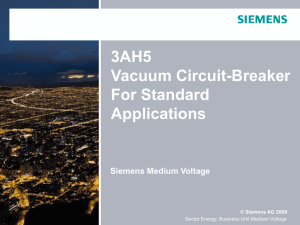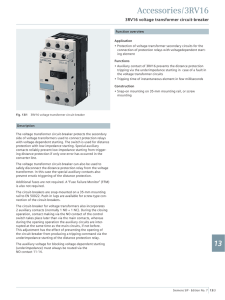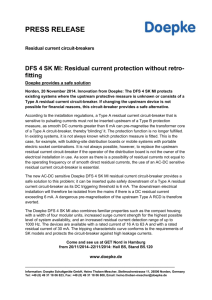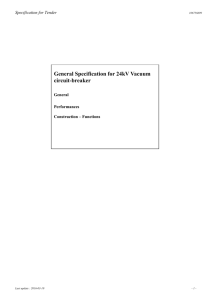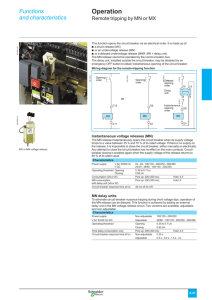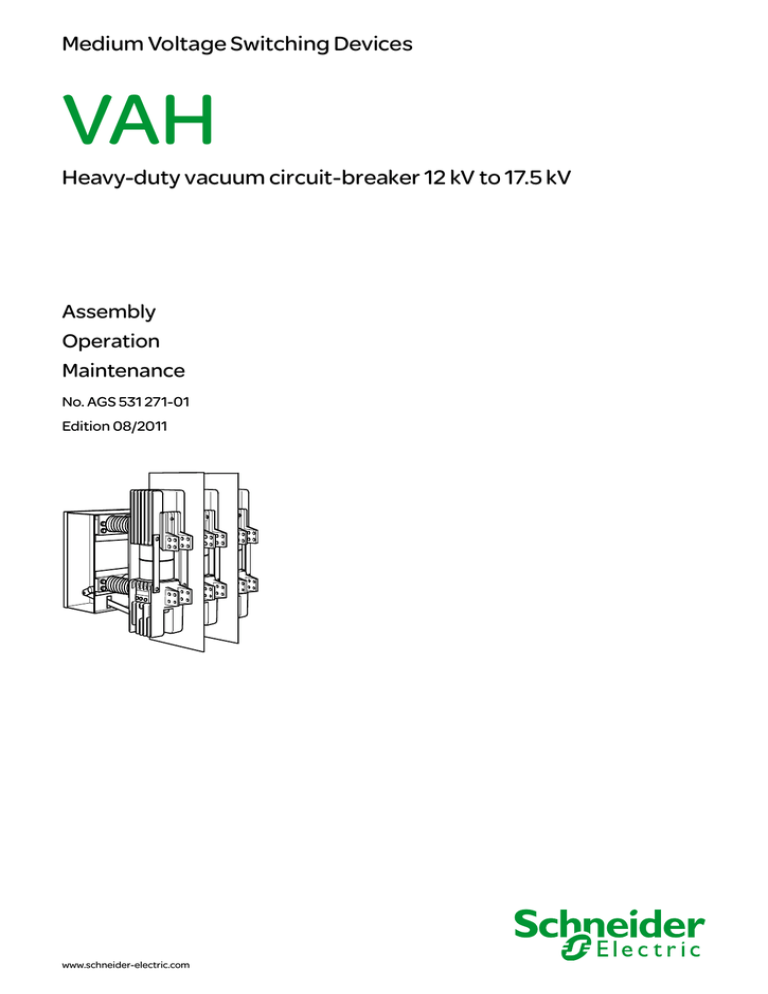
Medium Voltage Switching Devices
VAH
Heavy-duty vacuum circuit-breaker 12 kV to 17.5 kV
Assembly
Operation
Maintenance
No. AGS 531 271-01
Edition 08/2011
www.schneider-electric.com
Manufacturer:
Schneider Electric Sachsenwerk GmbH
Rathenaustrasse 2
D-93055 Regensburg
Germany ( +49 (0) 9 41 46 20-0
7 +49 (0) 9 41 46 20-418
Service:
Schneider Electric Sachsenwerk GmbH
Rathenaustrasse 2
D-93055 Regensburg
Germany
( +49 (0) 9 41 46 20-0
7 +49 (0) 9 41 46 20-418
VAH
Contents
Remarks on this manual ............................................................................. 4
Purpose and target group........................................................................................... 4
Reference documents ................................................................................................ 4
Terms and symbols used............................................................................................ 4
Abbreviations used ..................................................................................................... 4
Any questions or suggestions?................................................................................... 4
1
Safety Provisions .............................................................................. 5
2
Technical details................................................................................ 6
3
Overview of variants VAH............................................................... 11
4
Delivery, Storage and Transport .................................................... 13
5
Assembly ......................................................................................... 14
6
Commissioning ............................................................................... 20
7
Operation ......................................................................................... 21
8
Maintenance..................................................................................... 24
2.1
2.2
2.3
2.4
2.5
2.6
2.7
4.1
4.2
4.3
5.1
5.2
5.3
5.4
5.5
5.6
5.7
6.1
6.2
7.1
7.2
7.3
7.4
8.1
8.2
8.3
8.4
8.5
8.6
8.7
8.8
9
9.1
9.2
9.3
9.4
AGS 531 271-01 | Edition 08/2011
Dimensions ..................................................................................................... 6
Applied standards ........................................................................................... 6
Environmental and operating conditions ......................................................... 6
Nameplate....................................................................................................... 7
Control and actuation units ............................................................................. 8
Intended use ................................................................................................. 10
Disposal after the end of service life ............................................................. 10
Delivery ......................................................................................................... 13
Storage.......................................................................................................... 13
Transport of the circuit-breaker ..................................................................... 13
Before installation.......................................................................................... 14
Fixing the circuit-breaker in place ................................................................. 14
Fitting the partitions....................................................................................... 16
Interlocking further units................................................................................ 16
Connecting the busbars ................................................................................ 17
Earth connection ........................................................................................... 18
Connecting the control cables....................................................................... 19
Final steps..................................................................................................... 20
Checking switching functions and interlocks................................................. 20
Operator interface and operating elements................................................... 21
Charging the energy storing device .............................................................. 22
Switching operations ..................................................................................... 22
Fan attachment ............................................................................................ 23
Safety provisions........................................................................................... 24
Maintenance schedule .................................................................................. 25
Cleaning insulating components ................................................................... 26
Corrosion protection...................................................................................... 27
Condensation ................................................................................................ 27
Replacement of components ........................................................................ 27
Greasing the circuit-breaker pole and drive mechanisms ............................. 27
Maximum admissible numbers of breaking operations of vacuum chamber 31
Annex ............................................................................................... 33
Accessories................................................................................................... 33
Auxiliary products.......................................................................................... 33
Treatment of firmly screw-connected contact surfaces ................................. 33
Specifications for screw connections ............................................................ 34
3
VAH
Remarks on this manual
As our products are subject to continuous further development, we reserve the right
to make changes regarding standards, illustrations and technical data.
All dimensions specified in this manual are in millimeters.
Purpose and target group
This Technical Manual describes transport, assembly, operation and maintenance
of the series VAH vacuum circuit-breakers. It is exclusively intended for specialist
electricians who have been certified for the VAH series (training certificate).
This Technical Manual is an integral part of the product and must be kept accessible
at all times to persons performing assembly, operation of or maintenance on the
circuit-breaker. If the circuit-breaker is sold to new owners, they must receive this
document along with the switching device.
This Technical Manual cannot describe every imaginable individual case or every
customer-specific version of the product. For information which is not included in this
manual, please contact the manufacturer.
The following additional
documents must be complied
with:
Reference documents
■
Purchase agreement with the stipulations regarding the switch-specific equipment and the legal details
■
Switch-specific circuit diagrams and documentation
■
Project notes regarding the VAH circuit breaker
■
For assembly and operation of the circuit-breaker, the operating manual of the
switchgear in which it is operated must be complied with.
Terms and symbols used
This manual uses certain terms and symbols. They warn about dangers or provide
important information which must be complied with at all costs so as to avoid danger
and damage:
"Danger!"
This danger symbol warns about dangerous electrical voltage.
Contact with voltage may result in fatal injury!
"Warning!"
This danger symbol warns about the risk of injury. Please comply
with all the provisions identified by this symbol in order to avoid
death or serious injury.
"Important:"
This instruction symbol is used for information which is important to
avoid material damage.
Abbreviations used
U r:
Rated voltage
Isc:
Rated short-circuit breaking current
Ir:
Rated current
Any questions or suggestions?
Do you have any questions or suggestions regarding this manual, or do you require
further information?
We always strive to provide you with the best-possible information for optimum, safe
use of our products. Thus, do not hesitate to contact us if you have any recommendations, amendments or proposals for improvement.
4
AGS 531 271-01 | Edition 08/2011
VAH
1
Safety Provisions
The work described in this manual may only be performed by specialist electricians
who have proved their experience with the VAH series and the applicable safety
provisions.
Please read the whole manual carefully before working on the circuit-breaker.
Applicable standards
and regulations:
■
Common specifications for high-voltage switchgear and controlgear: IEC
62271-1
■
The locally applicable accident prevention, operating and work instructions
must be complied with.
■
Installation: IEC 61936-1/HD 637 S11
■
Operation of electrical equipment: EN 50110-11
The national standards applicable in the country where the equipment is to be
installed must be complied with.
1
Before performing work on the circuit-breaker, it is essential that you comply with the
following instructions:
Danger! Risk of fatalities due to high voltage. Isolation from high voltage and earthing must always be ensured before performing assembly or maintenance work.
Danger! Risk of fatalities due to high supply voltage. Isolation from supply voltage must always be ensured before performing assembly or maintenance work.
Warning! Risk of injury due to movable parts in mechanical drives. For maintenance work,
– isolate from supply voltage
– release the circuit-breaker's energy storing device by switching
it OFF-ON-OFF
Behaviour in case of incidents or
accidents
AGS 531 271-01 | Edition 08/2011
In case of fire or of internal faults, toxic and caustic decomposition products may be
produced. Comply with the locally applicable accident and safety provisions.
In case of personal injury, take first-aid measures or cause them to be taken.
5
VAH
2
2.1
Technical details
Dimensions
The dimensions of the individual VAH variants are specified in the selection list
"Vacuum Circuit Breaker type VA, VAA, VAH, VXA, VXB, VXC".
This document or additional customized dimensional drawings are available on
request.
2.2
Series VAH circuit-breakers are:
Type approval of vacuum
interrupter chambers
acc. to RöV
Applied standards
■
type-tested
■
dimensioned for indoor installation
■
corresponds to the requirementsfor AC switchgear for voltages above 1 kV acc.
to IEC 62271-100;
■
complies, regarding its switching capacity and insulating level, with ANSI C37....
(please enquire at the manufacturer's).
The vacuum interrupter chambers have been approved by the X-Ray Ordinance
(RöV) of the Federal Republic of Germany up to a maximum voltage amounting to
the rated short-time power-frequency voltage (rated power frequency withstand voltage) defined by DIN VDE/IEC. Thus, they satisfy the conditions for operation exempt
of approval up to the voltage in question according to the X-Ray Ordinance (RöV).
2.3
Environmental and operating conditions
VAH circuit-breakers may only be operated under normal operating conditions acc.
to IEC 62271-1. Operation under conditions deviating from these is only admissible
upon consultation with and with the written approval of the manufacturer.
Ambient conditions in accordance with IEC 62271-1
Temperature class
1
6
"Minus 5 indoors”1
Min./max. ambient temperature
°C
–5/+401
Average value over 24 hours
°C
≤ 351
mean rel. air humidity: 24 hour/1 month
%
≤ 95/≤ 90
Installation altitude above sea-level
m
≤ 10001
other values available on request
AGS 531 271-01 | Edition 08/2011
VAH
2
2.4
Technical details
Nameplate
The type designation on the nameplate (Fig. 1, item 1) specifies essential technical
data.
4
3
1
2
Fig. 1
Nameplate
1
Type designation
2
Technical data
3
Year of construction
4
Serial number
The following example shows the composition of the type designation:
VAH
17 - 63 - 50 - 40
Series VAH
Rated Voltage Ur = 17 kV
Rated short-circuit breaking current Isc = 63 kA
Rated normal current Ir = 5000 A
Pole center spacing 400 mm
When submitting enquiries to the manufacturer or ordering spare parts, the following
information is required:
■
Type designation
AGS 531 271-01 | Edition 08/2011
■
Serial number
■
Year of construction
7
VAH
2
Technical details
2.5
Control and actuation units
The drive is basically designed as well for manual tensioning of the energy-storing
device (make spring).
The drive may be equipped with further control and actuation units.
■
Push switch S21 - S25
–
■
actuated by the energy-storing device.
Auxiliary switches S1
–
are actuated by the switch shaft. The switching positions of the switch
elements are dependent on the switch status "Make" and "Break" of the
circuit-breaker.
–
12 / 16 / 20 pole versions may be supplied.
–
They are set in compliance with the wiring diagram. Refer to Fig. 3, page 9
regarding other settings.
A number of switch elements are reserved for internal breaker-control.
■
Shunt opening releases F11-F12
■
Shunt closing release F2
■
Blocking coil Y1
■
■
–
Blocking coils prevent the circuit breaker from being closed and opened
via the push-buttons “ON“ or “OFF“, as well as manual actuation of the
disconnector truck.
–
If the rated supply voltage has failed or is shut off, all blocking coils are in
"blocked" position.
Push switches S41 - S43
–
S41 and S42 actuated by the button "Make" and "Break"
–
S43 actuated by the button "Break"
Motor M1
–
■
–
■
for tensioning the energy-storing device (closing spring)
Anti-pumping relay (K01)
If an ON and OFF command is simultaneously and permanently present
at the circuit-breaker, the latter returns to its initial position after closing. It
remains in this initial position until the ON command is issued again. This
prevents continuous closing and opening (“pumping”).
Terminal strip (X01)
Information about the power consumption of coils and the motor is available from the
manufacturer.
To this effect, the auxiliary voltage data is required.
Power consumption of magnet
coils and motor:
Magnet coils / motor
Power consumption [W]
Shunt closing release
160
Shunt opening release
ca. 50
Under-voltage release without time delay
15
CT powered release
12
Blocking magnet
12
Motor
Motor tensioning time
8
200-250
≤ 12 s
AGS 531 271-01 | Edition 08/2011
VAH
2
Technical details
Auxiliary switches
The switching functions are set in the factory in accordance with the LV wiring draw
ings.
Other functions of the auxiliary switch may be set by means of adjustable cams.
Setting procedure:
1. Set circuit-breaker to "Break";
energy-storing device detensioned.
2.
Remove cover plate (loosen five screws).
3.
Set desired switch function.
4.
Latch cam in the driver again.
5.
Check whether or not the cam has latched in the changed position.
6.
Replace cover plate on completion of settings.
Cam
Viewing direction
for setting
Fig. 2
Setting the cams of the auxiliary switch
Position of cams for
setting procedure
circuit­breaker „Break“
circuit­breaker
Breake Make Advanced
break
contact
Delayed make
contact
Advanced
make
contact
Delayed
break
contact
Wiper
Auxiliary swich
made
Fig. 3
Possible switching functions of auxiliary switch (switching programm) Technical Data
Rated supply voltage
Switching capacity
VDC
[V]
24
[A]
8
Short-circuit level
Time constant T=L/R
Rated continuous current
AGS 531 271-01 | Edition 08/2011
VAC
48
60
110
220
4
3
2
1
120
230
10
100 A for a time period of 30 ms
[ms]
≤ 20
−
[A]
10
−
9
VAH
2
2.6
Technical details
Intended use
Series VAH vacuum circuit-breakers are exclusively intended as switching units in
air-insulating medium-voltage switchgear. They may only be used in the scope of the
specified standards and the switchgear-specific technical data. Any other utilization
constitutes improper use and may result in dangers and damage.
Liability Disclaimers
The manufacturer shall not be held responsible for damage which occurs if
■ instructions in this manual are not complied with,
■
the circuit-breaker is not operated according to its intended use (see above)
■
the circuit-breaker is assembled, connected or operated improperly,
■
accessories or spare parts are used which have not been approved by the
manufacturer,
■
the circuit-breaker is converted without the manufacturer’s approval, or if inad
missible parts are attached.
2.7
Disposal after the end of service life
A material and recycling data sheet is available for disposal of the vacuum circuitbreaker unit VAH at the end of its service life; this can be provided on request.
Disposal is performed by the manufacturer’s Service Center as a service subject to
a fee.
10
AGS 531 271-01 | Edition 08/2011
VAH
3
Overview of variants VAH
Fig. 4
Heavy-duty vacuum circuit-breaker VAH,
≤ 1250 A
Fig. 5
Heavy-duty vacuum circuit-breaker VAH,
≤ 1250 A on transport cassette
Fig. 6
Heavy-duty vacuum circuit-breaker VAH,
≤ 4000 A
Fig. 7
Heavy-duty vacuum circuit-breaker VAH,
≤ 4000 A on transport cassette
AGS 531 271-01 | Edition 08/2011
11
3
VAH
Overview of variants VAH
854
275
275
1816
501
673
Fig. 8
Heavy-duty vacuum circuit-breaker VAH, ≤ 8000 A with fan attachment
Fig. 9
Generator circuit-breaker VAH 17-63-50-40 meets the requirements of IEEE C37.013
12
12
AGS 531 271-01 | Edition 08/2011
VAH
4
Delivery, Storage and
Transport
4.1
Delivery
–
Handle shipping units carefully when unloading and unpacking them
–
Shipping units must be unpacked immediately after receipt. The insurance com
pany must be notified immediately about any damage occurred in transit
–
On delivery, the consignment must be checked for completeness.
–
The manufacturer must be notified in writing about any discrepancies.
4.2
Storage
The transport packaging is not intended for storage. The risk of storing the parts in
packed condition shall be the consignee's responsibility!
4.3
Transport of the circuit-breaker
Warning!
Make sure the crane mounting harness is strong enough to bear
the weight of the circuit-breaker!
Weights
■
Transport using a forklift truck:
Only transport the circuit-breaker on a pallet.
■
Transport without pallet:
on transport cassette according to Fig. 5 on page 11.
–
The circuit-breaker is lifted as shown in the drawing on the right. To this
effect, a crane mounting harness is required.
Fig. 10
Transport
1
AGS 531 271-01 | Edition 08/2011
–
Rated current
[A]
≤ 1250
≤ 4000
Weight
[kg]
200
500
1
The weights of the vacuum circuit-breaker VAH are approximate and include neither packing
nor transport cassette.
13
VAH
5
Assembly
5.1
Before installation
–
Dimensional drawings are supplied on request.
–
Check the technical data on the name plate.
–
Check auxiliary voltage of the incorporated control and actuation units.
The circuit-breaker is delivered in the position "Broken" and energy-storing device
"detensioned".
Warning!
Do not tension the energy-storing device before completing installation. Danger of injuries.
Warning!
Comply with the safety provisions in Chapter 1, page 5!
5.2
■
Fixing the circuit-breaker in place
Switching devices for direct attachment:
–
Fastening points are provided at the ends of the insulator
–
supports with predefined hole positions (Fig. 11).
–
In the event of an installation position (service position) differing from the
standard, harmonise installation position with the manufacturer.
–
The circuit-breaker must not be distorted by the fastening.
–
Screws and fitting parts are not supplied with the breaker.
Important:
Comply with the tightening torques specified for screw-fastening (refer
to Chapter 9 "Annex" as of page 33).
The circuit-breakers are supplied with fitted crane hooks.
Important:
After attachment the crane hooks must be removed.
M10
max.30
max.
70
max.20
max.30
140
40
max.
70
378
max.10
Fig. 11
Examples for fixing
14
AGS 531 271-01 | Edition 08/2011
VAH
5
Assembly
Fig. 12
Crane hooks (remove after fitting the breaker)
■
Switching devices on transport cassette:
–
Four drilled holes diam. 18 mm each are provided in the transport cassette
for fastening on the floor or on rails.
100
570
1
Fig. 13
1
Fastening points in the transport cassette
AGS 531 271-01 | Edition 08/2011
15
VAH
5
Assembly
5.3
Fitting the partitions
–
Fit two brackets on the supporting plate (centre switch pole) using 2 x M10
plastic screws.
–
Screw partitions onto brackets using 2 x M10 plastic screws.
–
In the case of double partitions, screw on 2nd partition at four places using
plastic disc spacers.
Important:
Comply with the tightening torques specified for screw-fastening (refer
to Chapter (refer to Chapter 9.4 on page 34).
M10
M10
1
2
Fig. 14
Attachment of partitions
1
Bracket
2
Plastic diskrennwandanbau
5.4
Interlocking further units
If, dependent on the position of the circuit-breaker, other devices shall be interlocked
or controlled, it must be borne in mind that the masses and forces acting for inter
locking purposes do not influence the switching behaviour of the circuit-breaker.
Please consult manufacturer.
16
AGS 531 271-01 | Edition 08/2011
VAH
5
Assembly
5.5
Connecting the busbars
Connection surfaces are surfaces for the passage of current. Material of the con
nection surfaces on the heavy-duty circuit-breaker:
silver-plated copper.
Warning!
Aluminium busbars must never be connected to silver-plated connection surfaces of the heavy-duty vacuum circuit-breaker.
Inadmissible matching of materials.
■
Take into consideration DIN 43 671 as regards the rating of continuous current.
Operators outside Germany should apply the relevant local regulations.
■
Maximum spacing from the nearest support point of the connections of the
circuit-breaker towards the switch pole axis:
–
at rated short-circuit breaking current 50 kA = 825 mm (3 x pole center
spacing).
–
at rated short-circuit breaking current 63 kA = 500 mm.
If the nearest supporting point is not situated in the direction of the breaker pole axis,
care must be taken that no higher current forces act on the circuit-breaker switch
pole.
Important:
●
Coat contact surfaces (refer to Chapter 9.3, page 33).
●
Comply with the tightening torques specified for screw-fastening
(refer to Chapter 9.4, page 34).
■
Make busbar bolt and screw connections in compliance with DIN 43 673.
The heavy-duty vacuum circuit-breaker must not be distorted by screwing on the
busbars.
Busbar cross-sections for
connection to the heavy-duty
vacuum circuit-breaker VAH
1
Rated current [A]
Minimum busbar cross section
[mm2]
Material
≤ 4000
Connection as DIN 43 671
Copper
> 4000
4000
Copper
5000 - 80001
8000
Copper
with ventilator set
1
1
1
1
1
Fig. 15
1
Busbar connection
AGS 531 271-01 | Edition 08/2011
17
VAH
5
5.6
Assembly
Earth connection
(Connect station earth to the earth connection of the circuit-breaker.)
■
Choose cross-section and material of the earth conductor in compliance with
DIN VDE 0141 or national installation specification.
Important:
●
Coat contact surfaces (refer to Chapter 9.3, page 33 ).
●
Comply with the tightening torques specified for screw-fastening
(refer to Chapter 9.4, page 34).
■
Protective earthing may also be established through the fastening screws in the
profile of the rear plates of the drive cabinet if galvanised ratchet screws are
used as fastening screws whose ratchet penetrates the varnish.
Admissible thermally active short- time current per ratchet screw M12: 4 kA (1 s);
2.7 kA (3 s).
■
Screw connections M12
Drive cabinet
95
M12
115
Fig. 16
Earth connection on heavy-duty vacuum circuit-breaker (steel)
500
M12
Fig. 17
Earth connection on transport cassette (steel)
18
AGS 531 271-01 | Edition 08/2011
VAH
5
5.7
Assembly
Connecting the control cables
Connection by means of (Fig. 18):
–
plug or
–
terminal strip in the drive cabinet.
1
2
Fig. 18
External control cables
1
Opening for control and auxiliary cables
2
Plug alternatively Externe Steuerleitungen
On connection by terminal strip
■ deinstall cover plate (five screws).
■
connect the external control cables through the terminal strip and lay them to
the outside through the opening in the drive cabinet.
The following may be connected:
■ flexible wires up to 1.5 mm2 (only on connection by plug)
■
solid single wires up to 2.5 mm2.
The binding wiring diagram is situated as adhesive circuit diagram on the inner side
of the cover plate.
■ If additional control cables are installed in the drive cabinet, sufficient spacing to
moving parts of the drive must be provided.
■ Reinstall cover plate after the external control cables have been connected.
Important:
Comply with the tightening torques specified for screw-fastening (refer
to Chapter 9.4 on page 34).
AGS 531 271-01 | Edition 08/2011
19
VAH
6
Commissioning
6.1
Final steps
Danger!
Risk of fatalities due to high voltage. All active parts must be
earthed.
Checking assembly
■
Check securing bolts.
■
Check the conductor bars’ screw connections using a torque wrench.
■
Check the screw connections of the earth terminal.
■
Check wiring laid on site.
Damaged paint
Minor damage to the paint can be repaired using a commercially available touch-up
pen (standard colour RAL 7044 or corresponding colour) (see Chapter 9.2 “Auxiliary
products” on page 33).
Inspection
■
Check the circuit-breaker for damage which might be due to transport or as
sembly work.
■
Compare the data on the nameplate (see Chapter 2.4 on page 7) to the re
quired rating specifications.
■
Check rated supply voltage of control and operating devices.
■
Check surfaces of insulating components for impurities. If necessary, clean (see
Chapter 8.3 on page 26).
6.2
Checking switching functions and interlocks
Danger!
The high-voltage supply must not be connected. All active parts
must be earthed.
Important:
● For switching operations, comply with Chapter 7 “Operation” as of
page 21.
● In case supply voltage is not available,
●
blocking coils (optional; lock circuit-breaker button in discon
nected position) are in locked position, thus blocking manual
switching operations;
–
there is a dropped-out undervoltage release in the circuitbreaker (optional).
The energy-storing device of the circuit-breaker drive is charged
autonomously as soon as the supply voltage is applied.
1.
Charge energy-storing device using the crank.
Check the spring position indicator.
2.
Switch circuit-breaker on and off several times by hand.
Check position indicator.
3.
Check electrical functions of control and operating devices.
4.
20
–
–
Apply auxiliary voltage
–
Perform switching operations and check for proper working order and the
function of the interlocks by actuating the shunt release.
–
Watch position indicator.
Check interlocks between circuitbreaker and other devices.
AGS 531 271-01 | Edition 08/2011
7
VAH
7.1
Operation
Operator interface and operating elements
1
2
7
6
3
4
5
Fig. 19
Operating elements
1
Name plate
2
Position indicator, energy-storing device (charged / released)
3
ON button
4
OFF button
5
Operating counter
6
Opening for crank to charge the enrgy-storing device
7
Position indicator ON / OFF
Position indicators on circuit-breaker and possible operating sequences
Pos.
Position indicator
Position indicator
Energy-storing device
(Closing spring)
ON/OFF ("Close/
Trip")
Switch position
Opening spring
Possible operating
sequence
1
released
OFF
released
none
2
charged
OFF
released,
is charged via C
C- O
3
released
ON
charged
4
charged
ON
charged,
is re-charged via C
C = Closing (ON)
O
O-C-O
O = Opening (OFF)
AGS 531 271-01 | Edition 08/2011
21
VAH
7
7.2
Operation
Charging the energy storing device
Manually
Initial position:
■
Circuit-breaker in "OFF" position.
■
Energy storing device "released"
(Table: Chapter 7.1, page 21, item
1)
1
Move circuit-breaker in "ready-for-clos
ing" position:
1.
Insert crank into opening for charg
ing the energy storing device.
2.
Perform approx. 35 turns (clock
wise) until position indicator
"charged" appears (starting the
motor during this procedure does
not involve a danger).
(Table: Chapter 7.1,on page 21,
item 2)
3.
After charging, remove the crank.
The circuit-breaker is ready for
closing.
2
Fig. 20
Charging the energy-storing device
manually
1
Insert crank
2
approx. 35 turns clockwise
Via motor
The energy storing device of motorized circuit-breakers is charged automatically as
soon as the motor's auxiliary voltage is applied.
7.3
Switching operations
Important:
The specific interlocks between the circuit-breaker and the panel must
be taken into account.
Closing (ON)
■
Push button "ON" - or
■
apply voltage to shunt closing release.
The position indicator shows the switch position "ON"
(Table: Chapter 7.1, page 21, item 3).
The position of the auxiliary switch has changed.
The energy storing device can be charged immediately after switching ON (by hand
or by motor).
If voltage is applied to the motor, charging is performed automatically.
(Table: Chapter 7.1, page 21, item 4)
Opening (OFF)
■
Push button "OFF" - or
■
switch off via shunt opening release, undervoltage release or secondary coil.
The position indicator shows the switch position "OFF"
(Table: Chapter 7.1, page 21, item 1 or 2).
The position of the auxiliary switch has changed.
22
AGS 531 271-01 | Edition 08/2011
VAH
7
7.4
Operation
Fan attachment
Fan modules are attached depending on the rated current Ir and the conductor bar
terminal cross section (see also ”System Configurations“ ´for the VAH circuit-break
er).
The fans are located above the switch poles and blow air onto the heat sink.
The system is equipped with compact fans, each equipped with an axial fan and
guard screen.
The fans are designed for min. 20,000 service hours under normal operating condi
tions (see Chapter 2.3, page 6), and do not require any maintenance.
Fan operation:
The fan does not start turning until the prevailing normal current has exceeded an
adjustable threshold.
Compact fan (Papst, 5656 S; 30 W power):
ON threshold: 4700 A
OFF threshold: 4500 A
Compact fan (ebm; W2E 200-HH 38-01; 80 W power):
ON threshold: 4800 A
OFF threshold: 4600 A
Air flow monitor:
To ensure the required cooling effect, the fans are monitored by air flow monitors.
These are located below the fans’ blow-out opening.
If there is no air flow due to failure of a fan, the air flow monitor issues a signal.
Measures in case of failure of
a fan:
■
Reduction of the maximum operating current to the appropriate fan ON thresh
old of the switching unit.
■
Contact the manufacturer’s Service Center.
1
2
3
4
Fig. 21
Heavy-duty vacuum switch VAH with fan module
1
Direction of air flow
2
Compact fan (shown: “ebm; W2E 200-HH 38-01“)
3
Air flow monitor
4
Connector terminal (24 poles)
AGS 531 271-01 | Edition 08/2011
23
VAH
8
Maintenance
8.1
Safety provisions
Maintenance and cleaning work may only be performed by specialist electricians
who have been certified by the manufacturer for maintenance work on the series
VAH vacuum circuit-breakers and who are familiar with the appropriate safety provi
sions.
Warning!
Comply with the safety provisions in Chapter 1, page 5!
Warning!
The circuit-breaker must not be disassembled for maintenance
work!
“Use in line with the intended purpose” jeopardised (see Chapter
2.6 on page 10).
Safety precautions:
1.
24
On principle, the 5 safety rules applicable for electrical engineering must be
complied with before maintenance work on the circuit-breaker is started. These
rules apply for all live parts:
■ Isolating from the power supply
■
Securing from reclosing
■
Ensuring zero voltage
■
Earthing and short-circuiting
■
Covering or cordoning off adjacent live components.
2.
Switch off the auxiliary voltage for the circuit-breaker drive and secure it against
reclosing.
3.
Release the energy-storing device by performing the corresponding operating
sequence on the circuit-breaker:
OFF - ON - OFF (see Chapter 7, as of page 21).
AGS 531 271-01 | Edition 08/2011
VAH
8
8.2
Maintenance
Maintenance schedule
Series VAH vacuum circuit-breakers are indoor switching devices designed for normal operating conditions in acc. with IEC 62271-1.
Inspection
It is recommended to check the circuit-breakers visually at regular intervals depending on the strain they are subject to during operation and in accordance with national
regulations.
Important:
In case of frequent condensation or air pollution (dust, smoke or corrosive gases), the maintenance intervals must be adapted to the actual
conditions.
A visual inspection includes a complete check of the circuit-breaker for contamination, condensation and damage, to be performed by certified staff.
Maintenance
If there are signs of contamination or condensation, the circuit-breakers must be
cleaned in an expert manner (see Chapters 8.3 and 8.4 on page 27) and subsequently the drives, interlocks and position indicators checked for proper functioning
(see Chapter 7 as of page 21).
Overhauling
If damage is detected, it must be repaired immediately, or components replaced.
In case of ambiguities or irregularities, please contact the manufacturer’s Service
Center immediately.
Maintenance interval
Maintenance work
After 20 years
■
■
AGS 531 271-01 | Edition 08/2011
Qualification /
Work performed
by
Clean and grease circuitbreaker
(see Chapter 8.3, page 26 Staff who have
and Chapter 8.7, page 27) been certified for
this work
Perform several switching
tests
After 10 000 operating
cycles
Revision of the circuitbreaker
once the max. admissible
number of breaking operations for the vacuum chambers has been reached
(see Chapter 8.8, page 31)
Replacement of circuitbreaker poles
Manufacturer’s
Service Center
25
VAH
8
8.3
Maintenance
Cleaning insulating components
To secure the specified insulating level, the insulators must be clean.
The following parts must be
cleaned:
■
post insulators
■
operating rods
■
connection plates
■
ceramic of the vacuum switching chambers
■
partitions
Moreover, general cleanliness of the circuit-breaker and of its external parts should
be ensured.
Use a dry cleaning cloth in case
of slight soiling:
Clean by means of a dry, lint-free cloth. Depending on quantity of dirt collected,
replace cloth as often as necessary.
Use cleaning agents in case of
severe soiling:
Cleaning agent 1 liter can, Order no. S 008152
The use of other cleaning agents is not admissible.
■ Wear protective gloves
■
Use the cleaning agent according to the manufacturer’s instructions
■
Soak the cloth thoroughly and wipe the insulating components. Keep duration
of contact as short as possible.
■
Expose the cleaned surface to the air for at least 2 hours.
Fig. 22
VAH circuit-breaker
26
Insulating components which must be cleaned at regular intervals
AGS 531 271-01 | Edition 08/2011
VAH
8
8.4
Maintenance
Corrosion protection
Drive mechanisms and covers have a long-term protection against corrosion. Any
damage to the paint, scratches and other damage must be remedied immediately to
avoid corrosion.
Contact the manufacturer’s Service Center.
8.5
Condensation
To ensure the specified insulating level, the VAH circuit-breaker – especially its insu
lating components – must not be exposed to condensation.
Measures to take in case of condensation:
1.
If condensation of the circuit-breaker is detected, the switching device must be
cleaned according to Chapter 8.3, page 26 .
2.
Installation or inspection of the appropriate heating. It must provide a sufficient
heating performance to prevent condensation on the circuit-breaker.
8.6
Replacement of components
Drive or live high-voltage components may be replaced as required. The following data on the nameplate are relevant for replacement of components or in case of any queries (see also Chapter 2.4, page 7):
■ Type designation
■
Serial number
■
Year of construction
If you have any queries regarding replacement of components, please contact the
manufacturer’s Service Center.
8.7
Greasing the circuit-breaker pole and drive
mechanisms
Important:
The following elements must not be lubricated:
● charging gears
AGS 531 271-01 | Edition 08/2011
●
motor
●
ball-bearings and sliding bearings
●
auxiliary Make release
●
auxiliary Break release
●
push switch Make-Break
●
push switch "Energy-storing device"
●
auxiliary switches
●
tappets of all release coils
27
VAH
8
Grease switch poles:
O
Maintenance
Liquid lubricant FL
Order no. S 008 153, on bearings, articulated joints and guides.
Apply liquid lubricant in drops (oil can, drip-feed oiler) in the bearing gap. Through
capillary action the liquid lubricant runs between the bearing surfaces. Use extension
pipe or spray at inaccessible lubrication points.
Fig. 23
Circuit-breaker pole VAH 1250 A / 2500 A / 3150 A, lower section, lubrication points
Fig. 24
Circuit-breaker pole VAH 4000 A / 8000 A, lower section, lubrication points
28
AGS 531 271-01 | Edition 08/2011
VAH
8
Maintenance
Removing the operating panel:
Tool: TORX screwdriver, size T25 / slotted screwdriver Remove the 5 x M5 screws on the front and remove the operating panel.
Put operating panel and screws in a safe place for subsequent reassembly.
Once lubrication of the drive
mechanism is complete:
1.
Put the operating panel back on.
Tightening torque for the securing bolts: 3.8 - 5.6 Nm.
2.
Put circuit-breaker into operation again according to Chapter 6, as of page 20
“Commissioning”.
1
1
1
1
Fig. 25
Frontplate of VAH circuit-breaker
1
Securing bolts
Lubrication the drive:
Fig. 26
Lubrication points in the drive (overview drawing see Fig. 27, page 30)
AGS 531 271-01 | Edition 08/2011
29
VAH
8
Lubrication procedure:
Maintenance
Synthetic lubricant
Order no. ST 312-111-835, on sliding surfaces
Clean lubrication points, e.g. with a non-fluffy cotton cloth or soft brush and deter
gent (use little, moisten only lubrication points). Apply a thin film of synthetic lubri
cant.
Liquid lubricant FL
Order no. S 008 153 on bearings, articulated joints and guides
Apply the liquid lubricant in drops (oil can, drip-feed lubricator) in the bearing gap.
The liquid lubricant runs between the bearing surfaces through capillary action. Use
extension pipe or spray at inaccessible points.
11
10
1
2
9
8
3
7
6
4
5
Fig. 27
Lubrication points in the drive
Synthetic lubricant
Liquid lubricant FL
30
AGS 531 271-01 | Edition 08/2011
8
VAH
Maintenance
8.8
Maximum admissible numbers of breaking
operations of vacuum chamber
The diagrams (Fig. 28 and Fig. 30) define exclusively the max. admissible numbers
of breaking operations of the circuit-breaker depending on the rated normal current Ir
and of the short-circuit breaking current Isc. They indicate when the vacuum inter
rupter chambers need to be replaced.
The diagrams show examples of values for the rated normal current Ir and the shortcircuit breaking current Isc.
The data for the rated normal current Ir and the short-circuit breaking current Isc are
indicated on the nameplate (see Fig. 29, page 32 for generator circuit-breaker VAH
in acc. with IEEE C37.013).
VAH circuit-breaker in acc. with
IEC 62271-100
example: VAH 12-50-40-27
VAH 12-63-40-27
Number of breaking operations [n]
100000
10000
1000
100
Isc = 50 kA
30
20
Isc = 63 kA
10
1
0
1
4
10
50 63
100
Ratings Ir und ISC [kA]
Fig. 28
Admissible breaking numbers for the vacuum chamber with values (example)
Ir = rated normal current = 4 kA
Isc = short-circuit breaking current = 50 kA and 63 kA
AGS 531 271-01 | Edition 08/2011
31
8
VAH
Maintenance
Generator circuit-breaker
VAH in acc. with IEEE C37.013
2
1
Fig. 29
Data for rated normal current Ir (1) and short-circuit breaking current Isc (2) on the
nameplate
Number of breaking operations [n]
100000
10000
1000
100
50
10
1
0
1
5
10
63
100
Ratings Ir und ISC [kA]
Fig. 30
Admissible breaking numbers for the vacuum chamber with values (example)
Ir = rated normal current = 5 kA
Isc = short-circuit breaking current 63 kA
32
AGS 531 271-01 | Edition 08/2011
VAH
9
Annex
9.1
Accessories
Designation
Order no.
Manual crank
AGS 617 810-01
9.2
Auxiliary products
The auxiliary products are available from the manufacturer. The use of alternative
auxiliary products is not permissible.
Warning!
Risk of injury if these products are handled improperly.
Observe the safety data sheets of the manufacturers of the auxiliary products.
Designation
Order no.
Synthetic lubricant, 0,5-kg can
ST 312-111-835
Liquid lubricant FL, 0,5-kg can
S 008 153
Cleaning agent, 1-l can
S 008 152
Touch-up pen RAL 7044, silk-grey, 50 ml
S 009 561
Touch-up pen, special paint (specify colour shade) S 009 562
9.3
Treatment of firmly screw-connected contact
surfaces
Important:
■ Caution when handling bars insulated by heat-shrinkable sleeves:
The heat-shrinkable sleeve must not get into contact with contact
grease (swelling).
■ Contact areas coated with contact grease should not be touched,
if possible.
1.
Contact areas must be subjected to preliminary treatment before screw-fasten
ing (see Table below)
2.
Immediately after the pre-treatment, coat the contact surfaces with contact
grease, so that the space between the contact surfaces is completely filled
once the screws have been connected.
Material of contact surfaces
Pre-treatment
Silver-plated
Cleaning1
Nickel-plated
Remove passivation layer4
Copper or copper alloy
Clean1, expose metallic surface2
Aluminium
Clean1, expose metallic surface2
Steel
Clean1, expose metallic surface2
Zinc-plated steel
Remove passivation, not, however, the zinc
layer3
Hot-galvanized sheet-metal
Clean1, passivation need not be removed
1
2
3
4
AGS 531 271-01 | Edition 08/2011
Clean by means of lint-free cloth; use cleaning agent in case of serious con
tamination
Expose metallic surface
- by treating the entire surface with emery cloth or a rotating grinding tool (grain
size 100 or 80) or
- using a wire brush which is clearly marked for use exclusively for aluminium or
exclusively for copper
using a brass brush, steel brush
rub slightly by hand using Scotchbrite abrasive agent (Ni layer must not be
reduced)
33
VAH
9
Annex
9.4
Specifications for screw connections
Important:
■ The threads of screws and bolts must generally not be pre-trea
ted!
■ Max. tolerance for the effective tightening torques: ±15%
■
The nut must correspond in strength to the grade of the screw/bolt
used or be of better quality.
General screw connections
Grade or material
Screw/bolt
Plastics
Thread Ø
≥ 8.8 ≤ 10.9
Self-locking screw
≥ 8.8
Tightening torques [Nm]
M4
0.25
2.6
M5
0.5
5.0
7.0
M6
0.8
8.8
12.3
M8
1.8
21.0
30.0
M 10
3.5
42.0
59.0
M 12
6.0
70.0
97
M 16
12
170
M 20
330
Screw fastening for power
transmission
Screw connection for terminal
strips
Screws and bolts: Grade ≥ 8.8
Conductor material: copper
Thread Ø
34
Tightening
torques [Nm]
Thread Ø
Tightening
torques [Nm]
M 2.5 (M 2.6)
0.5
M6
6.5
M3
0.7
M8
17
M 3.5
1.0
M 10
35
M4
1.5
M 12
68
M5
2.5
M 16
135
AGS 531 271-01 | Edition 08/2011
© Schneider Electric 2011 – All rights reserved to this technical manual. Reproduction and making available of this technical manual, or extracts, to third parties are prohibited.
Only integral reproduction of this technical manual is permitted with the written permission from Schneider Electric. Electronic copies in e.g. PDF-format or scanned version
have the status “for information only” . The only valid version of this technical manual is always enclosed directly to the product in question by the factory.
Schneider Electric
35, rue Joseph Monier
CS 30323
92506 Rueil-Malmaison Cedex, France
As our products are subject to continuous development, we reserve the
right to make changes regarding the standards, illustrations and technical
data described in this Technical Manual. For any requests, please contact
the address given below.
RCS Nanterre 954 503 439
Capital social 896 313 776 €
www.schneider-electric.com
Schneider Electric Sachsenwerk GmbH
Rathenaustrasse 2
D-93055 Regensburg, Germany
( +49 (0) 9 41 46 20-0
7 +49 (0) 9 41 46 20-418
AGS 531 271-01 | 08/2011

